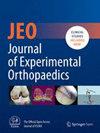Characteristics of gait pelvic jerk in individuals with femoroacetabular impingement syndrome
Abstract
Purpose
Despite a consensus on gait kinematic changes caused by femoroacetabular impingement (FAI), the characteristics of kinetic changes in patients with FAI remain unclear. Therefore, this study aimed to investigate whether pelvic jerk, which can be assessed by inertial sensors, can detect kinetic differences between individuals with FAI and asymptomatic controls and the association between pelvic jerk and patient-reported outcome measures in individuals with FAI.
Methods
Thirty patients with FAI and 30 asymptomatic controls participated in this study. To obtain the pelvic jerk time series, all participants walked 10 m at a self-selected speed using a third lumbar internal sensor. The peak values of the pelvic jerk in the first and second halves of the stance phases (1st- and 2nd-peak pelvic jerks) were also analysed. The patient-reported outcome measures of individuals with FAI were the international hip outcome tool-33, hip outcome score-activities of daily living, and modified Harris hip score.
Results
The FAI group showed lower pelvic jerk than the control group in the first (3%–18% gait cycle) and second halves (42%–54%, 57%–67%) of the stance phase based on the statistical parametric mapping analysis (p < 0.05), and also lower peak values corresponding to the respective gait cycles (1st-peak pelvic jerk, p < 0.001; 2nd-peak pelvic jerk, p = 0.002). Multivariate linear regression analysis showed that 1st-peak pelvic jerk was positively associated with all patient-reported outcome measures.
Conclusion
Gait kinetic changes in the FAI group were characterised by reduced 1st- and 2nd-peak pelvic jerks. The reduced 1st-peak pelvic jerk is associated with hip function disability in individuals with FAI. Pelvic jerk may be a simple and quantitative indicator of FAI, although the relevance of this metric must be confirmed in the future studies.
Level of Evidence
Level III, case–control study.




 求助内容:
求助内容: 应助结果提醒方式:
应助结果提醒方式:


